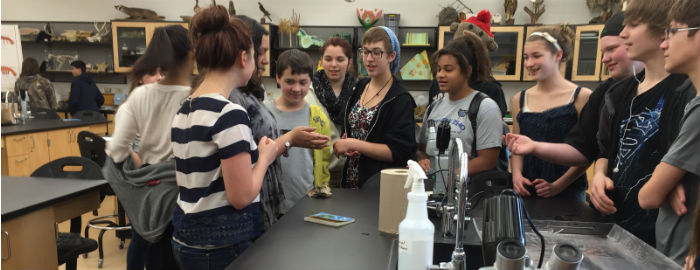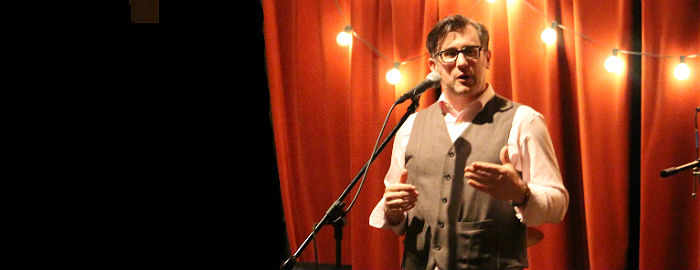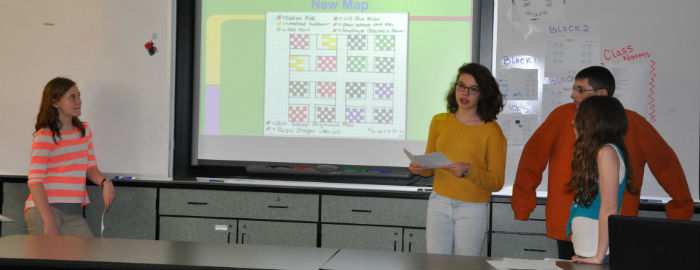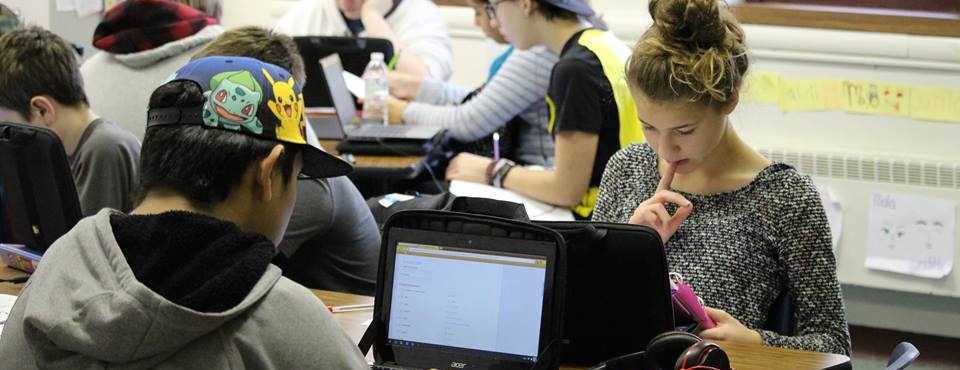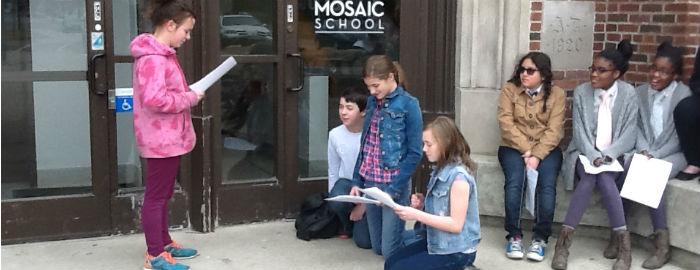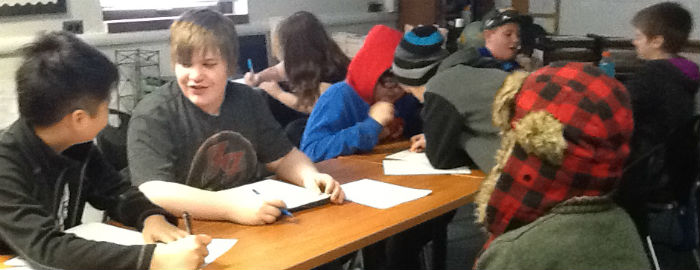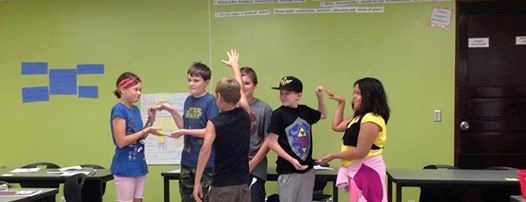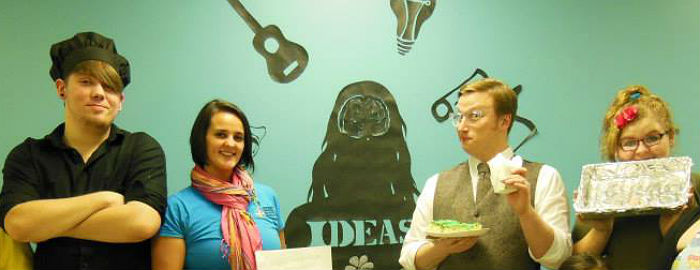by: Tad Phippen Wente, Chief Curatorial Officer
Gallery News: May 1, 2015
 Feeling bored? I mean, board? When you stroll through the halls at IDEAS Academy and The Mosaic School you will see boards and be able to touch them, too. During a March artists collaboration with Sebura and Gartelmann at the JMKAC, Mosaic students learned about visual aspects of original messages and designed their own signs using various sized panels. The signs speak in bold colors about safe, memorable, and peaceful places. Étude Studios Intern Erik Tetschlag has gathered these and fashioned them into wall decor and a sculpture to keep the students’ learning and messages visible to all.
Feeling bored? I mean, board? When you stroll through the halls at IDEAS Academy and The Mosaic School you will see boards and be able to touch them, too. During a March artists collaboration with Sebura and Gartelmann at the JMKAC, Mosaic students learned about visual aspects of original messages and designed their own signs using various sized panels. The signs speak in bold colors about safe, memorable, and peaceful places. Étude Studios Intern Erik Tetschlag has gathered these and fashioned them into wall decor and a sculpture to keep the students’ learning and messages visible to all.
In the Pisces Gallery, Math teacher Courtney Kooistra exhibits the process of student thinking in designing an original park. The Ideation, Research, and Creation phases of the project are described above examples of different mind maps, written proposals and color-coded scale drawings for new parks. The Driving Question for the project: How can I use my knowledge of ratios, rates and proportions to create a scale map of a park detailed enough for another person to create?
A Socratic Seminar is made visible outside of the Mosaic Language Arts room. Analytical Thematic Statements and Talking Maps show the students’ process of thinking as they analyzed and learned from stories. Formal, word processed papers demonstrate quality academic writing. Underneath are designs, like some sort of Fibonacci-esque string art, showing the patterns of classroom discussion among all the students. In the Socratic Seminar, questions rule and inquiry and discussion are valued over debate. Students learn to explore ideas with each other and engage everyone in the conversation.
Making learning visible in the galleries at Mosaic has consequences. True, the halls are decorated. The work provides memories of past events. But students also see, every day, the learning they have accomplished. They can connect it with new learning. It jogs their memories. Classes can return to it, point, touch, talk through it again, whether to revisit a concept or a thinking process used.
Best of all are the times we catch them, in pairs or small groups, maybe before or after school, or during a passing period, conversing again about the learning, the reasoning, the whys and wherefores, the next times… The Thinking lives.
by: Tad Phippen Wente
8th Graders visit UW-Sheboygan
A “Welcome Mosaic 8th Graders” sign greeted students as they entered a quiet Acuity Technology Center building at UW-Sheboygan on April 29 for a morning campus tour.
by: Press Release
Étude Group Director selected to participate in WAB Creative Industries Committee
Madison, WI (April 29,2015) – Ted Hamm, Director, Principal and Founder of the The Étude Group has been selected to be a member of the Creative Industries Committee. The Creative Industries Committee is a board of experts comprised by The Wisconsin Arts Board to guide the Arts Board’s work to serve and promote the creative industries in Wisconsin.
by: Autumn Willard, Étude Studios Intern
Mosaic and IDEAS students explore sustainability
Mosaic School students participated in a Lexicon for Sustainability event held at the Mead Public Library Wednesday, April 22. IDEAS Academy Botany students curated the event. It was set up like a scavenger hunt encouraging students to read the various art posters and talk to different student speakers. Mosaic Students eagerly looked at the different parts of each piece asking various questions about the ideas presented.
by: N. Lynn Goldstein, Étude Studios Publication Design Intern
The Mosaic School works together to fertilize a better community
On March 20, 2015, Rachel Gunderson and her Mosaic science students came together and put on a presentation for Sheboygan ecologist Scott Horzen, two Caan’s representatives, and UW-Madison student Owen Schneider, that demonstrated the students’ knowledge on the “Mosaic Garden” project that they would like to make happen. Whispers from the audience clearly showed interest in this idea, some stating that they have been involved since the idea was first brought up. The Mosaic School science classes created five different garden plans and then collaborated to propose one big and unique garden together that would host native plants of Wisconsin.
by: Erica Brown
Final Shadow Day
Students interested in learning more about The Mosaic School are invited to attend our Shadow Day on Tuesday, April 14th from 8:05 to 3:15 p.m.
by: Colleen Machut
An introduction to Theater from Many Lands & Times
On Wednesday, March 11th Mosaic students began new seminar classes for Trimester 3. Students have the opportunity to take two different seminars each trimester and can choose between six creative disciplines: Music, Creative Writing, Dance, Visual Art, Engineering, and Drama. Part of this choice includes what we call a "project seminar," or a seminar wherein they will do an in depth interpretation of an academic concept through the art form they are studying in the seminar. An example of this from Trimester 2 is the Animation Sensations[/middleschool/community/mosaic-gallery/new-portfolio-page/] seminar and an extension of this at IDEAS Academy is IDEAS Project Block[/highschool/community/ideas-gallery/].
by: Colleen Machut
A look inside Mosaic Social Studies
In social studies, Mosaic students are learning to think like social scientists and function as active citizens. This trimester they will explore human rights in the context of different historical events. To start their exploration, students chose the area of human rights that they were most interested in, and then they were organized into groups based on those interests. The image above depicts students collaborating to develop a driving question and an idea for their trimester-long project. They will spend the rest of the year building from their own inquiry and incorporating class activities to create relevance and interpret meaning.
by: Erica Brown
Information Night
Students and families interested in learning more about The Mosaic School are invited to attend our Information Night on Tuesday, March 24th from 6:00-7:15 p.m.
by: Rachel Gunderson, Mosaic Think Tank Advisor
IDEAS & Mosaic Think Tanks host Community Night, March 13th
IDEAS and Mosaic Think Tanks have collaborated to host a Community Night featuring dinner and a talent show. Dinner will be provided through a cook-off, where students and staff will bring their best dish and serve it up to the guests who will then vote on their favorite. A winner will be announced at the end of the event. Entertainment will be provided by the brave and talented students who are interested in performing for the school. The event will begin at 5:00pm on Friday, March 13th and conclude at 7:00pm in the IDEAS/Mosaic Cafeteria.

